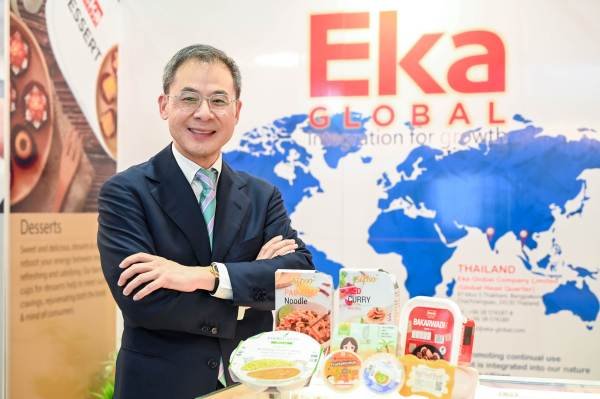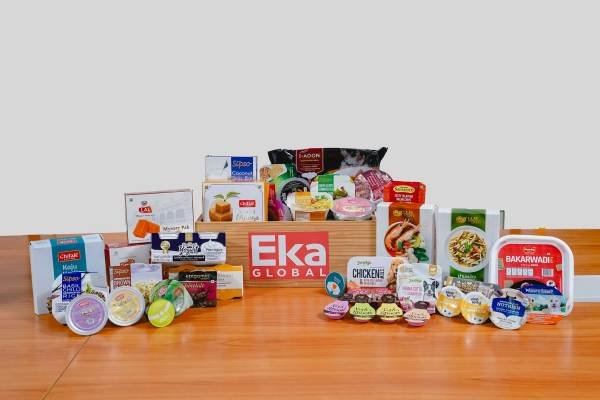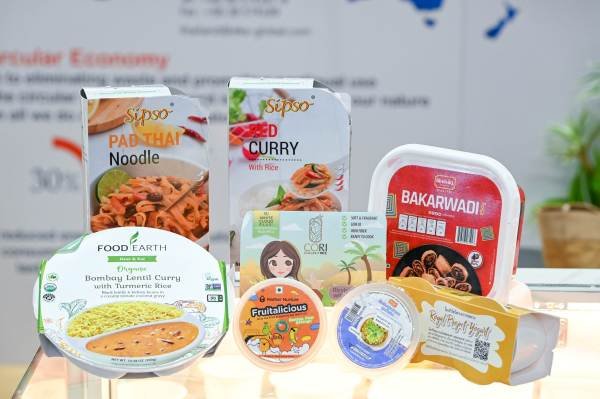“เอกา โกลบอล” หนุนไทยลดปริมาณ “ขยะอาหาร” ลง 50% ในปี 2573 แนะภาคธุรกิจใช้เทคโนโลยีบรรจุภัณฑ์ยืดอายุอาหาร (Longevity Packaging) แก้ปัญหาตั้งแต่ต้นทาง มั่นใจเป็นเครื่องมือสำคัญช่วยไทยบรรลุเป้า เผยเทรนด์โลกหนุนตลาดบรรจุภัณฑ์ยืดอายุเติบโตต่อเนื่องเป็นตัวเลขสองหลัก
นายชัยวัฒน์ นันทิรุจ ประธานเจ้าหน้าที่บริหาร บริษัท เอกา โกลบอล จำกัด (EKA GLOBAL) ผู้นำตลาดนวัตกรรมบรรจุภัณฑ์ยืดอายุอาหาร (Longevity Packaging) แบรนด์คนไทยเบอร์ใหญ่อันดับต้น ๆ ของโลก เปิดเผยว่า สถานการณ์ “ขยะอาหาร” (Food Waste) ในประเทศไทยยังคงเป็นประเด็นเร่งด่วน โดยข้อมูลล่าสุดจากกรมควบคุมมลพิษ (คพ.) ณ ปี 2568 พบว่า ขยะอาหารในประเทศมีปริมาณสูงถึง 10 ล้านตันต่อปี คิดเป็นสัดส่วน 36 – 39% ของขยะชุมชนทั้งหมด และคนไทยสร้างขยะอาหารเฉลี่ยสูงถึง 154 กิโลกรัมต่อคนต่อปี ซึ่งเป็นอัตราที่สูงกว่าค่าเฉลี่ยโลก
ทั้งนี้ ประเทศไทยได้ผลักดัน “แผนขับเคลื่อนประเทศไทยสู่เป้าหมาย Zero Food Waste” พร้อมประกาศให้ปีนี้ เป็น “ปีแห่งการเริ่มต้นรณรงค์ลดขยะอาหาร” เพื่อมุ่งลดปริมาณขยะอาหารลง 50% ภายในปี 2573 ตามเป้าหมายการพัฒนาที่ยั่งยืนขององค์การสหประชาชาติ
นายชัยวัฒน์ กล่าวว่า การแก้ปัญหาขยะอาหารอย่างยั่งยืนควรเริ่มที่ “การป้องกันไม่ให้เกิดขยะตั้งแต่แรก” มากกว่าการจัดการที่ปลายทาง โดยภาคเอกชนต้องเข้ามามีบทบาทสำคัญในการประยุกต์ใช้เทคโนโลยีบรรจุภัณฑ์ยืดอายุอาหาร (Longevity Packaging) โดยเทคโนโลยีบรรจุภัณฑ์ยืดอายุอาหาร เช่น Modified Atmosphere Packaging (MAP) ให้ผลบวกอย่างเป็นรูปธรรม ทั้งช่วยลดการสูญเสียอาหาร (Food Loss) และช่วยยืดอายุความสดใหม่ของอาหารและวัตถุดิบอย่างมีนัยสำคัญ ตั้งแต่การจัดเก็บ การขนส่ง จนถึงชั้นวางขาย เป็นการป้องกันการเน่าเสียก่อนถึงมือผู้บริโภค

นอกจากนี้ยังรักษาคุณภาพและความปลอดภัย (Food Safety) ช่วยคงคุณค่าทางโภชนาการ รสชาติ และเนื้อสัมผัส รวมถึงป้องกันการปนเปื้อน ตลอดจนถึงการลดการเน่าเสียของวัตถุดิบแม้เพียง 1 – 2% สามารถช่วยประหยัดต้นทุนและลดความเสียหายทางเศรษฐกิจในภาคอุตสาหกรรมอาหารได้หลายแสนล้านบาทต่อปี
สำหรับภาพรวมตลาดบรรจุภัณฑ์ยืดอายุอาหาร มองทิศทางการเติบโตยังคงสดใส สอดคล้องกับเมกะเทรนด์ด้านความยั่งยืนและการบริโภคอาหารพร้อมรับประทานที่เพิ่มขึ้นทั่วโลก โดยมองตัวเลขการเติบโตของตลาดนวัตกรรมบรรจุภัณฑ์อาหารในภูมิภาคนี้จะยังคงมีการเติบโตที่แข็งแกร่งอย่างต่อเนื่อง โดยมีอัตราการเติบโตเฉลี่ยอยู่ที่ประมาณ 5 – 10% ต่อปี โดยเฉพาะในกลุ่มอาหารพร้อมรับประทาน (Ready-to-Eat) ซึ่งเป็นตลาดสำคัญของบรรจุภัณฑ์ยืดอายุอาหาร
ขณะที่ ประมาณการณ์แนวโน้มการส่งออกอาหารพร้อมรับประทานของไทยยังเป็นตลาดที่คาดว่าจะเติบโตด้วยอัตราที่สูงกว่าการค้าโลกโดยเฉลี่ย ข้อมูลโดยสภาหอการค้าไทย สภาอุตสาหกรรมฯ และสถาบันอาหาร มองมูลค่าการส่งออกสินค้าอาหารไทยโดยรวมในปีนี้จะเติบโตกว่า 1.75 ล้านล้านบาท เพิ่มขึ้น 6.8%
ด้านศูนย์วิจัยกรุงศรี คาดการณ์การเติบโตของปริมาณส่งออกอาหารพร้อมรับประทานปี 2568 – 2569 จะขยายตัวเฉลี่ย 5 – 6% ต่อปี มีแรงหนุนจากพฤติกรรมผู้บริโภค ไม่ว่าจะเป็นการขยายตัวของสังคมเมือง วิถีชีวิตที่เร่งรีบ และการให้ความสำคัญกับอาหารที่มีคุณภาพ สะอาด และมีอายุการเก็บรักษานาน ทำให้ความต้องการอาหารพร้อมรับประทานที่ใช้บรรจุภัณฑ์ยืดอายุอาหารเพิ่มสูงขึ้นอย่างมาก อย่างไรก็ดีผู้ประกอบการต้องติดตามความเสี่ยงด้านเศรษฐกิจและนโยบายภาษีระหว่างประเทศอย่างใกล้ชิด
“การลงทุนในเทคโนโลยีบรรจุภัณฑ์ช่วยยืดอายุอาหารจึงเป็นการลงทุนที่สร้างผลบวกต่อสังคมและสิ่งแวดล้อมอย่างยั่งยืน เพราะช่วยแก้ปัญหาขยะอาหารได้ตั้งแต่ต้นทาง และยังช่วยให้ประเทศไทยสามารถบรรลุเป้าหมายการลดขยะอาหารได้อย่างเป็นรูปธรรม” นายชัยวัฒน์ กล่าว

Eka Global Urges Shift to Longevity Packaging to Help Thailand Cut Food Waste by 50% by 2027
Committed to supporting Thailand’s goal of reducing food waste by 50% by 2027, Eka Global, one of the world’s leading producers of longevity packaging, is calling on Thai food manufacturers to adopt advanced packaging solutions to prevent food loss and boost the country’s sustainability efforts.
Longevity packaging, which helps extend shelf life and reduce spoilage, is rapidly becoming a global trend, with double-digit annual growth. By embracing this innovation, Thai food producers can not only contribute to national sustainability goals but also enhance their competitiveness in international markets.
Chaiwat Nantiruj, Group CEO of Eka Global, emphasized the urgency of addressing food waste in Thailand. According to 2025 data from the Department of Pollution Control, Thailand generates up to 10 million tons of food waste annually – accounting for 36% to 39% of total community waste. On average, each Thai citizen contributes approximately 154 kilograms of food waste per year, significantly exceeding the global average.
Thailand has introduced the “Zero Food Waste Plan” and announced that 2025 marks the beginning of its national food waste reduction campaign. The plan aims to reduce food loss and waste by 50% by 2027. This national initiative is in line with the United Nations Sustainable Development Goals (SDGs).
Chaiwat added that preventing food from becoming waste is more effective than managing it at the end of the cycle. He emphasized that the private sector has an important role to play in adopting longevity packaging and advanced technologies such as Modified Atmosphere Packaging (MAP) to create a meaningful impact. Longevity packaging, combined with modern food processing and packaging technologies, can significantly reduce food loss while keeping food and ingredients fresh throughout the entire supply chain — from storage and transport to shelf display.
Longevity packaging also enhances food safety by preserving nutritional value, taste, and texture, while preventing contamination. Even a small reduction, just 1–2%, in raw ingredient deterioration can save the food industry hundreds of thousands of baht annually in costs and economic losses.
The longevity packaging trend continues to grow, driven by global sustainability concerns and rising demand for ready-to-eat meals. In this region, innovative food packaging is expected to grow 5–10% annually, with the ready-to-eat segment leading the way.
On the export front, ready-to-eat meals from Thailand are expected to grow above the global average. Recent reports from the Thai Chamber of Commerce, the Federation of Thai Industries, and the Food Institute forecast that Thailand’s total food exports will grow by 6.8%, reaching over 1.75 trillion baht.
Krungsri Research forecasts that Thailand’s ready-to-eat meal sector will grow by an average of 5–6% annually between 2025 and 2026. This steady growth is driven by shifting consumer behavior, increasing urbanization, fast-paced lifestyles, and rising demand for high-quality, hygienic food with longer shelf life — all of which are fueling demand for longevity packaging. However, food producers are advised to closely monitor potential risks related to economic conditions and international trade policies.
“Investing in innovative longevity packaging technology creates a positive impact by supporting both social and environmental sustainability. It not only prevents food from becoming waste but also helps Thailand make real progress toward its national goal of reducing food waste,” said Chaiwat.





